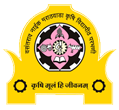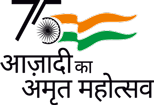Cotton Research Station Nanded
I) Cotton varieties released during last five years
Release of American cotton (G. hirsutum)
1) NHH 44 BG II :
1. Intra hirsutum Bt cotton hybrid NHH 44 BG II was released for cultivation under rainfed regions of Central Zone (Maharashtra, Gujarat and Madhya Pradesh) by Central Variety Release Committee, New Delhi in year 2018.
2. The silent features of intra hirsutum Bt cotton hybrid NHH 44 BG II :
a) Productivity : 22-25 q/ha (Rainfed)
b) Ginning Outturn : 37-38 %
c) Fibre Length : 25-26 mm
d) Special features :
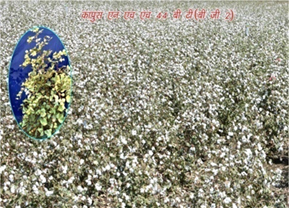

2) NH 1901 Bt :
1. Bt cotton variety NH 1901 Bt was released for cultivation under rainfed regions of Central Zone (Maharashtra, Gujarat and Madhya Pradesh) by Central Variety Release Committee, New Delhi in year 2023.
2. The silent features of Bt cotton variety NH 1901 Bt:
a) Productivity : 14-16 q/ha (Rainfed)
b) Ginning Outturn : 33-36 %
c) Fibre Length : 25-26 mm
d) Fibre strength : 25-26 g/tex
e) Micronaire : 4.17 µ/inch
f) Special features
3) NH 1902 Bt :
1. Bt cotton variety NH 1902 Bt was released for cultivation under rainfed regions of Central Zone (Maharashtra, Gujarat and Madhya Pradesh) by Central Variety Release Committee, New Delhi in year 2023.
2. The silent features of Bt cotton variety NH 1902 Bt:
a) Productivity : 15-17 q/ha (Rainfed)
b) Ginning Outturn : 35-37 %
c) Fibre Length : 25-26 mm
d) Fibre strength : 25-26 g/tex
e) Micronaire : 4.60 µ/inch
f) Special features
4) NH 1904 Bt :
1. Bt cotton variety NH 1904 Bt was released for cultivation under rainfed regions of Central Zone (Maharashtra, Gujarat and Madhya Pradesh) by Central Variety Release Committee, New Delhi in year 2023.
2. The silent features of Bt cotton variety NH 1904 Bt:
a) Productivity : 13-15 q/ha (Rainfed)
b) Ginning Outturn : 36-37 %
c) Fibre Length : 25-26 mm
d) Fibre strength : 25-26 g/tex
e) Micronaire : 4.60 µ/inch
f) Special features
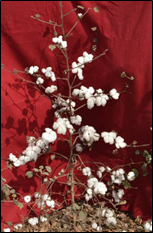
NH 1901
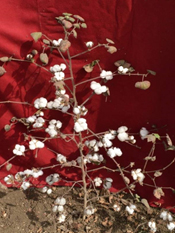
NH 1902
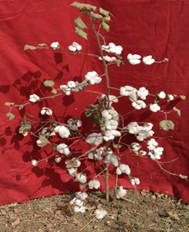
NH 1903
Release of American cotton (G. hirsutum)
1) NH 677 :
1. G. hirsutum cotton variety NH 677 was released for cultivation under rainfed regions of Maharashtra by Joint AGRESCO and State Seed Sub-Committee, Maharashtra state in year 2023.
2. The silent features of G. hirsutum cotton variety NH 677:
a) Productivity : 14-16 q/ha (Rainfed)
b) Ginning Outturn : 36-37 %
c) Fibre Length : 25-26 mm
d) Special features :
Release of Desi cotton (G. arboreum) variety
1) PA 740 :
Desi cotton variety PA 740 was released for cultivation under rainfed regions of South Zone (Telangana, Andhra Pradesh, Karnataka and Tamil Nadu) by Central Variety Release Committee, New Delhi in year 2019. The variety was also released for cultivation in Marathwada region of Maharashtra by Joint AGRESCO and notified in the year 2019.
1. This variety is having high yield and excellent fibre properties.
2. The silent features of the variety PA 740 :
a) Productivity : 15-16 q/ha
b) Ginning Outturn : 36-37 %
c) Fibre Length : 36-37 %
d) Fibre strength : 27-28 g/tex
e) Micronaire : 4.5 µ/inch
f) Spinning counts : 30s
g) Duration : 150-160 days
h) Special features :
2) PA 812 :
Desi cotton variety PA 812 was released for cultivation under rainfed regions of Central Zone (Maharashtra, Gujarat and Madhya Pradesh) by Central Variety Release Committee, New Delhi in year 2020.
3. This variety is having high yield and excellent fibre properties.
4. The silent features of the variety PA 812 :
a) Productivity : 15-16 q/ha
b) Ginning Outturn : 34-35 %
c) Fibre Length : 29-30 mm
d) Fibre strength : 29-30 g/tex
e) Micronaire : 4.5 µ/inch
f) Spinning counts : 30
g) Duration : 150-160 days
h) Special features :
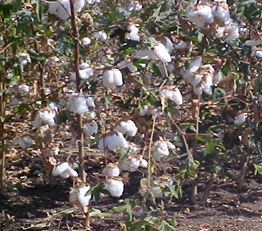
PA 740
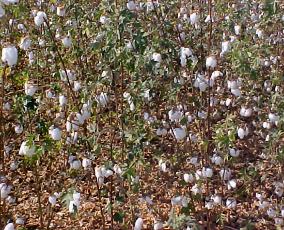
PA 812
3) PA 810 :
Desi cotton variety PA 810 was released for cultivation under rainfed regions of Central Zone (Maharashtra, Gujarat and Madhya Pradesh) by Central Variety Release Committee, New Delhi in year 2021. The silent features of the variety PA 810 :
a) Productivity : 15-16 q/ha
b) Ginning Outturn : 33-34 %
c) Fibre Length : 29-30 mm
d) Fibre strength : 28-29 g/tex
e) Micronaire : 4.5 µ/inch
f) Spinning counts : 30s
g) Duration : 150-160 days
h) Special features :

PA 740

PA 812
4) PA 837 :
Desi cotton variety PA 837 was released for cultivation under rainfed regions of South Zone (Telangana, Andhra Pradesh, Karnataka and Tamil Nadu) by Central Variety Release Committee New Delhi, in year 2022. The silent features of the variety PA 837 :
a) Productivity : 15-16 q/ha
b) Ginning Outturn : 35-36 %
c) Fibre Length : 28-29 mm
d) Fibre strength : 27-28 g/tex
e) Micronaire : 4.8 µ/inch
f) Spinning counts : 30s
g) Duration : 150-160 days
h) Special features :
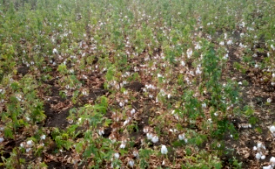
PA 810
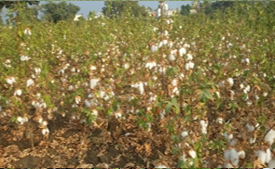
PA 837
5) PA 833 :
Desi cotton variety PA 833 was released for cultivation under rainfed regions of South Zone (Telangana, Andhra Pradesh, Karnataka and Tamil Nadu) by Central Variety Identification Committee in year 2023. The silent features of the variety PA 833 :
a) Productivity : 15-16 q/ha
b) Ginning Outturn : 35-36 %
c) Fibre Length : 28-29 mm
d) Fibre strength : 27-28 g/tex
e) Micronaire : 4.8 µ/inch
f) Spinning counts : 30s
g) Duration : 150-160 days
h) Special features :
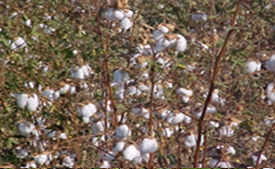
PA 833
II) Technologies Recommended
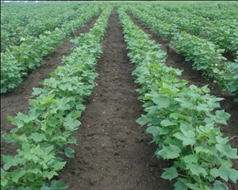
Spacing 120 x 45 cm Inder Rainfed
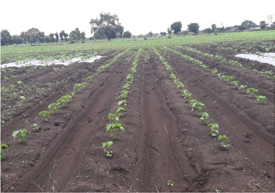
BBF + PE and PoE weedicides
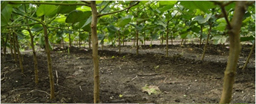
High density planting of cotton
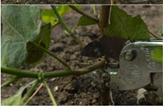
Prunning of monopodia
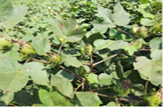
Detopping
III) Memorandum of Understanding
IV) Varieties/hybrids registered under PPVFRA, New Delhi
| Sr. No. | Name of Crop | Crop Group | Name of Variety/Hybrid | Category of vVariety/Hybrid | Registration Number | Date of Certificate issue |
|---|---|---|---|---|---|---|
| 1. | Cotton (G,arboreum) | Cash crop | PA 402 (Vinayak) | Extant variety | 12/2013 | 31/01/2013 |
| 2. | Cotton (G,arboreum) | Cash crop | PA 255 (Parbhani Turab) | Extant variety | 13/2013 | 31/01/2013 |
| 3. | Cotton (G,arboreum) | Cash crop | PH 348 | Extant variety | 824 of 2014 | 29/12/2014 |
| 4. | Cotton (G,arboreum) | Cash crop | NH 545 | Extant variety | 826 of 2014 | 29/12/2014 |
| 5. | Cotton (G,arboreum) | Cash crop | NH 615 | Extant variety | 44 of 2014 | 05/02/2014 |
V) Extension Activities (2021-22 to 2023-24)
| Sr. No. | Particulars | 2021-22 | 2022-23 | 2023-24 |
|---|---|---|---|---|
| A) | Extension Programs Organized | |||
| i. | Trainings | 1 | 1 | 1 |
| ii. | Kisan Mela | 1 | 1 | 2 |
| B) | Extension Programs Participated | |||
| i. | Kisan Mela and Training Psrograms | 18 | 11 | 10 |
| ii. | Exhibition | 3 | 5 | 3 |
| iii. | Field Visits | 14 | 23 | 29 |
| C) | Extension Publications | |||
| i. | Folders | 2 | 4 | 2 |
| ii. | Radio Talks | 3 | 4 | 4 |
| iii. | Popular Articles | 3 | 5 | 5 |
VI) TSP and SCSP activities
a) Tribal Sub Plan
| Particular/Year | Budget sanctioned (Rs) | Expenditure (Rs) | Balance (Rs) |
|---|---|---|---|
| 2022-23 | ₹2,68,000 | ₹2,67,916 | ₹84 |
Sanctioned Budget : ₹2.68 lakh
Number of beneficiaries : 170
Targets and Achievements
| Sr. No. | Particular | Unit | Annual Total | |
|---|---|---|---|---|
| Target | Achievements | |||
| 1. | Trainings (Capacity building) (1 day) | No. | 1 | 1 |
| 2. | Awareness camps, exposure visits etc. | No. | 4 | 4 |
| 3. | Input Distribution Plant protection chemicals | Kg | 0.85 | 0.85 |
| 4. | Development of Literature | No. | 1 | 1 |
Inputs distributed
b) Scheduled Cast Sub Plan
| Particular/Year | Budget sanctioned (Rs) | Expenditure (Rs) | Balance (Rs) |
|---|---|---|---|
| 2022-23 | ₹3,00,000 | ₹2,98,504 | ₹1,496 |
Sanctioned Budget : ₹3.00 lakh
Number of beneficiaries : 87
Targets and Achievements
| Sr. No. | Particular | Unit | Annual Total | |
|---|---|---|---|---|
| Target | Achievements | |||
| 1. | Trainings (Capacity building) (1 day) | No. | 1 | 1 |
| 2. | Awareness camps, exposure visits etc. | No. | 8 | 11 |
| 3. | Input Distribution Plant protection chemicals | Kg | 0.85 | 0.85 |
| Fertilizers (NPK) | Qt | 43.5 | 43.5 | |
| 4. | Development of Literature | No. | 1 | 1 |
Inputs distributed
VI) Scientist Details
| Sr. No. | Name of post | Sanctioned Post | Filled Post | Vacant Post | Name of Scientist / Staff | Year Since ICAR-AICRP on Cotton |
|---|---|---|---|---|---|---|
| AICRP on Cotton, Nanded (Main centre) | ||||||
| 1. | Associate Professor (Breeding) | 1 | 1 | Nil | Dr. V. N. Chinchane | 2021 |
| 2. | Assistant Professor (Agronomy) | 1 | 1 | Nil | Dr. V. K. Khargkharate | 2005 |
| 3. | Assistant Professor (Entomology) | 1 | 1 | Nil | Dr. B. V. Bhede | 2021 |
| 4. | Assistant Professor (Plant Pathology) | 1 | 1 | Nil | Dr. P. K. Dhoke | 2008 |
| CRS, Nanded – Non plan / NARP schemes | ||||||
| 1. | Professor (Breeding) | 1 | 1 | Nil | Dr. K. S. Baig | 2013 |
| 2. | Assistant Professor (Agronomy) | 1 | 1 | Nil | Dr. A. D. Pandagale | 2007 |
| 3. | Assistant Professor (Seed Technology) | 0 | 1 | - | Dr. S. N. Devkule | 2023 |
| 4. | Assistant Professor (Statistics) | 1 | Nil | 1 | - | - |
| Total | 6 | 7 | Nil | |||
